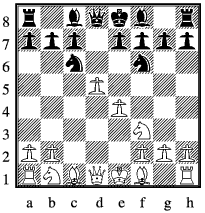
November 2011

|
| RR v Geoff Laurence after 6 d5 |
6 ... Nxe4, 7 Bb5 Bd7, 8 dxc6 now fine,
6 ... Nxe4, 7 Bb5 a6, 8 dxc6 Qxd1+, 9 Kxd1 Nxf2+
10 Ke2 Nxh1, 11 cxb7+ with bxa8Q to follow. Don't mind that.
Same line 10 ... axb5, 11 cxb7 Bxb7, Kxf2 and Geoff has given up knight for two pawns.
Try again
6 ... Nxe4, 7 Bb5 a6, 8 dxc6 Qxd1+, 9 Kxd1
Now 9 ... axb5, 11 cxb7 Bxb7 I've lost a pawn and the chance to castle. Not a good line for white.
So I need 8 Ba4 which protects the queen so prevents the fork on f2.
What else could I try? 7 Qd3 so both knights under threat.
Geoff plays 6 ... Nb8.
Later at home I discover that 7 Be2 is a very effective riposte to 6 Nxe4. It doesn't block the queen, but protects it to threaten dxc6. If the c6 knight moves the other one falls to Qa4+. And I'm ready to castle. Would I have found this if necessary? Onwards.
7 Bg5 c6, 8 Nc3 Qa5, 9 Qd2 h6, 10 Bxf6 gxf6, 11 Rd1 Bg4
12 Be2 Qc7, 13 h3 Bxf3, 14 Bxf3 Nd7, 15 dxc6 bxc6, 16 0-0 h5
17 Qc2 Ne5, 18 Be2 h4 Didn't think this advanced black's cause - was expecting e6 to keep my knight out of d5, free his bishop onto the queenside if desired and create a little freedom for his king.
19 Nd5 Qc8 see diagram right.
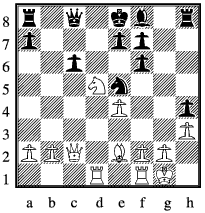
|
| RR v Geoff Laurence after 19 ... Qc8 |
Instead RR didn't even try Rc1 choosing the tame continuation
20 Ne3 e6, 21 f4 Nd7, 22 Rf3 Rg8, 23 Ng4 Be7, 24 Rc3 Rg6
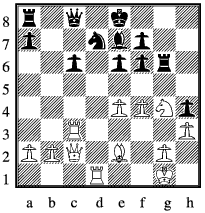
|
| RR v Geoff Laurence after 24 Rg6 |
About 15 minutes left on the clock and I just couldn't come up with a plan. I felt f5 was right but couldn't see why at the time so settled for Bb5+, not that a check is a plan.
28 Bb5+ Ke7, 29 Rc1 running scared of allowing the black knight into e4 with a possible knight and rook mate if my rook then leaves the back row.
There were more moves, but with both time and ideas in short supply RR's position went downhill fast, and he duly ended up coming second. With the team losing 3½ - 4½ RR felt as sick as the proverbial parrot.
comment on this article
With Hassell no more and Cheddleton reducing their entry to six teams, running a fifth division was no longer viable, so we are back to four. Meir's plans were subjected to shifting sands as player availability became problematic. After announcing two teams in division three and one in four at the AGM, they flirted with moving one into the second before settling on just two teams, both in division four.
| Division 3 | ||||||||||||||||||||||||||||||||||||||||||||||||||||||
|
| Division 4 | ||||||||||||||||||||||||||||||||||||||||||||||||
|
Teams in divisions three and four behaved themselves, getting their matches played in accordance with the fixture list. Consequently it is sensible to reproduce the early season tables for future reference. Newcastle top and tail the third, and already only one team in each division is pointless and only one team, Fenton C, within these two divisions having a 100% record. Looks like we are lining up another competitive season here.
Divisions one and two have had a patchy start, with he cross charts not as well populated with results as they should have been at this stage.
Overall there has been one match defaulted - Fenton failed to raise a team in the Intermediate Cup to visit Cheddleton, and another whose status is unknown - Alsager did not get a team out for the Open cup at Stafford, but I do not know at the moment whether that is a concession or a postponement. There are four outstanding postponements, two in each of the top two divisions, the Kings v Newcastle A fixtures have been reversed, and one match - Rooks v Knights - was played a week early. The bottom divisions haven't been quite perfect though, as all the defaulted boards have appeared down there, Pawns being responsible for three and Alsager D for one.
Communication of results has been variable, with Kidsgrove, Meir and sometimes Alsager being slower to submit scorecards than the other clubs.
Early predictions anyone?
comment on this article
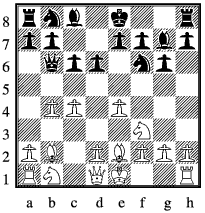
|
| RR v Michael Connor after 6 ... Qb6 |
7 Qb3 0-0, 8 Nc3 Bg4, 9 0-0 Nbd7, 10 a4 Nc5, 11 Qc2
RR had vague hopes of trapping the black queen if it grabs the b-pawn, but exact calculation rather than vague hopes should be the order of the day. In fact Qa3 allowing the e-pawn to fall is superior as in taking this pawn black has to allow the exchange of the dark square bishops. There followed
11 ... Qxb4, 12 Ba3 (black is threatening Nfxe4, which cannot be taken by the white knight as it would reveal a double attack on his b2 bishop.)
12 ... Qa5, 13 Rab1 Rab8, 14 Bb4 Qc7, 15 d4 Ne6
16 Qd2 Nd7, 17 d5 Nec5, 18 a5 offering another pawn.
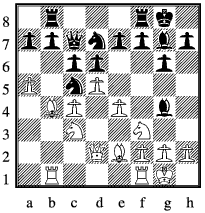
|
| RR v Michael Connor after 18 a5 |
19 ... Nxe4, 20 Qe3 Ndf6, 21 h3 Bd7, 22 g4 Grabbing the a-pawn may be better as it helps reduce the material imbalance, but RR is in attack mode - a rare sight.
22 ... Nc5, 23 Qh6 (ignoring 23 Bxc5 and 24 Qxe7)
23 ... e5, 24 Nxe5 cxd5, 25 g5 Ne8, 26 Nxd7 Nxd7
27 Rfc1 d4, 28 Rd1 Ng7, 29 Bg4 f5, 30 gxf6 Nxf6
31 Rxd4 Nxg4, 32 hxg4
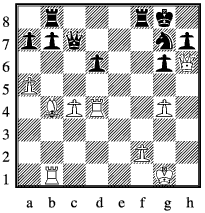
|
| RR v Michael Connor after 32 hxg4 |
32 ... Rbd8, 33 Rbd1 Rf6 (another pair of reds)
34 Qh2 Ne8 (two more!), 35 c5 d5, 36 Qg2 Rf4
RR now spent too long comparing the merits of Rxf4 and Rxd5 and lost on time.
Defeat in round one meant RR effectively got upfloated into the top section for round two, getting a full point bye whilst playing black against Luke Boumphrey.
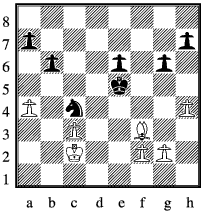
|
| Luke Boumphrey v RR after 28 ... Ke5 |
29 Be2 Kd5, 30 Bf3+ Kc5, 31 Be4 Nd6, 32 Bd3 e5, 33 f3 Nc8
34 g4 Ne7, 35 Be4 a5, 36 Kb3 Nd5, 37 h5
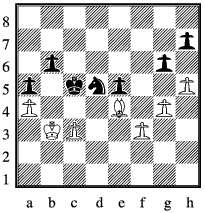
|
| Luke Boumphrey v RR after 37 h5 |
37 ... gxh5, 38 g5 Pardon. Can he play that and live?
38 ... h4, 39 Bxh7 h3, 40 f4 h2, 41 Be4 Nxf4
42 Kb2 b5, 43 axb5 Kxb5, 44 Kb3 a4+, 45 Ka3 Kc4
46 Kxa4 Kxc3, 47 Kb5 Kd4, 48 Bh1 e4 0-1
Black against Harry Baxter was RR's next assignment.
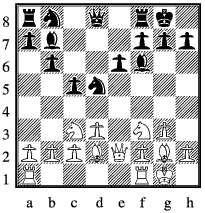
|
| Harry Baxter v RR after 10 ... Bf6 |
11 Ne5 Bxe5, 12 Qxe5 Nc6 (development with gain of tempo)
13 Qh5 Nd4 and white now embarks on a big material exchange on d5 without checking what would happen afterwards. Black on the other hand not only looked ahead but could always halt the exchanges with a pawn capture any time he wanted.
14 Nxd5 Bxd5, 15 Bxd5 Qxd5, 16 Qxd5 exd5 Suddenly white sees that he has given himself one move to prevent both the fork on f3 and the loss of his c-pawn, an impossible task.
17 Bc3 Ne2+ (... Nxc2, 18 Rc1 and whichever retreat black selects white removes the knight doubling a pawn and limiting his advantage)
18 Kg2 Nxc3, 19 bxc3 RR will have a lasting advantage in the endgame.
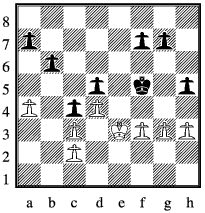
|
| Harry Baxter v RR after 29 ... Kf5 |
36 h6 gxh6, 37 h5 a5 making full use of the waiting moves available
38 Kg2 f4, 39 Kh3 Kxf3, 40 Kh4 Ke4 Not even allowing white a sniff at queening a pawn of his own. White resigned a few moves later.
Round 4 against G Sage went pear-shaped from a reasonable position in the middlegame, with RR failing to stay cool under attack - his chosen moves advancing the attackers cause rather than his own.
Round five with white against Damien McCarthy also saw RR in generous mode, carelessly discarding a pawn in an attempt to retain access to a square which was probably not that important. Needless to say lots of material then came off so that when considering move 29 RR was the proud(?) possessor of the position right.
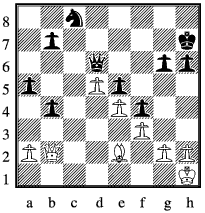
|
| RR v Damien McCarthy after 28 ... Nxc8 |
29 g3 g5, 30 gxf4 gxf4, 31 Bf1 Qc7, 32 Bh3 Ne7
33 Be6 Qc3, 34 Qe2 Qe3, 35 Qf1 (possibly exchanging the queens and hoping that I can hold the piece ending is better, but this is more complicated!)
35 ... a4, 36 Qh3
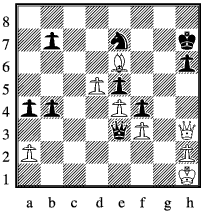
|
| RR v Damien McCarthy after 36 Qh3 |
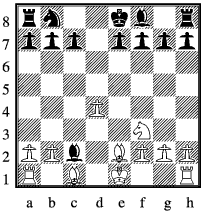
|
| Ken Wozniak v RR after 8 ... Bxc2 |
11 0-0 e6, 12 Nd2 Bd5, 13 b3 Ba3, 14 Rc2 0-0
15 Bf3 Bxf3 No I'm not going to allow you to close the d-file.
16 Nxf3 Nd7, 17 Ne5 Nf6 Not taking that even though it would give me control of the d-file with my rooks. Stick to plan A.
18 Nc4 Be7, 19 Rd1 Natural, though in this case a dim knight (Na5) would have been brighter.
19 ... Rfd8, 20 Rcd2 Nd5
in due course the d-pawn becames pinned against its protectors, and black's kingside pawns march past. We rejoin with Ken still plaqued by his problem d-pawn and with a bishop short of squares.
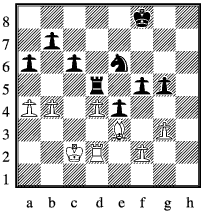
|
| Ken Wozniak v RR after 40 ... hxg5 |
Exhibit A: RR has a passive position against Ivor Annetts as we join their first round game.
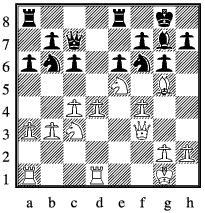
|
| Ivor Annetts v RR after 17 b3 |
18 ... c5 (not Nxe5 enabling white to get a stranglehold.)
19 dxc5 Nxe5, 20 fxe5 Nd7, 21 Ne4 Nxe5, 22 Qf4 A tempting pin, but it helps the game to turn.
22 ... f5, 23 Nf6+ Bxf6, 24 Bxf6 Qxc5+, 25 Kh1 Ng4.
As a result of the last few moves black has a backward pawn on an open file weak black squares around his king. Is his judgement that correct that these weakneses are in this case less important than the pawn he holds?
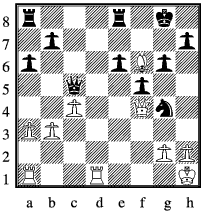
|
| Ivor Annetts v RR after 25 ... Ng4 |
26 ... Qe7, 27 Qg3 Rad8 (an immediate e5 probably better)
28 h3 e5, 29 hxg4 Rxd4, 30 Rxd4 exd4, 31 gxf5 Qxe3
32 Qxe3 Rxe3, 33 fxg6 hxg6, 34 Rb1 Rc3, 35 Kg1 d3
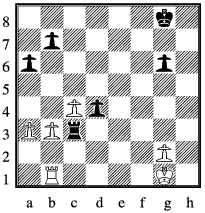
|
| Ivor Annetts v RR after 35 Kg1 |

|
| RR v William Elworthy after 30 ... Q(c7)d8 |
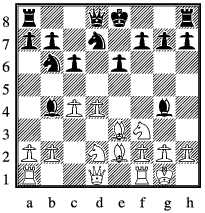
|
| Russell Pegg v RR after 9 ... N8d7 |
10 a3 Bxd2, 11 Nxd2 (Qxd2 or Bxd2 are met by Bxf3) Bxe2
1 Qxe2 h6 (Qh4, removing her majesty from the central files is better)
13 Rac1 0-0, 14 Rfd1 Nf6, 15 Qf3 Rc8, 16 Ne4 Nxe4
17 Qxe4 Nd7, 18 h3 Nf6, 19 Qh4 Nh7, 20 Qg3 Qf6
21 Qe5 Rfd8, 22 Qxf6 Nxf6 Russell's patience has run out in his attempts to be nasty on the kingside, so he takes the queens off. RR's long term plan is intact, and he may be looking at an ending with R+N v R+B, which traditionally favours the knight holder.
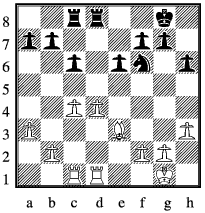
|
| Russell Pegg v RR after 22 ... Nxf6 |
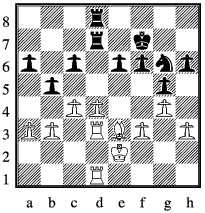
|
| Russell Pegg v RR after 34... Ng6 |
35 Rc1 Not good. bxc4, 36 bxc4 Russell took some time over this move. He didn't want to allow me the b-file, nor surrender the d5 square to my knight. He admitted afterwards that he hadn't noticed that capturing with the rook would have allowed Ne5 delivering considerable pain.
With the b-file his RR started dictating, creating weaknesses in exchange for simplification. We rejoin nearly 20 moves later.
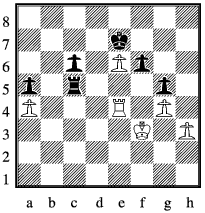
|
| Russell Pegg v RR after 54 K(g2)f3 |

|
| RR v Roger Greatorex after 20 ... f4 |
Death followed.
Last round. RR with white launched a hack attack against Jon Duckham, and we join it with RR definitely winning - yes he is a piece and two pawns up. However the sight of that mate in one threat instead of sharpening RR's thoughts seemed to reduce them treacle instead.
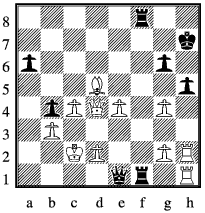
|
| RR v Jon Duckham after 36 ... Qe1 |
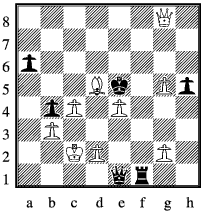
|
| RR v Jon Duckham after 45 K(f6)e5 |
Another Quiz: 46 Qb8+ Kd4, 47 Qh8+ Kc5, 48 d4+ Kb6 (Kd6, 49 Qd8 mate)
49 Qb8+ Ka5, 50 Qc7 the end.
comment on this article
|
Thanks to Ian for pointing out some typos in this article as it originally appeared. I also have trouble with perpetuals. I spot ones for myself that don't in fact exist, and fail to notice that my opponents perpetuals aren't because they end in mate. My first quiz answer is wrong. I had assumed that white's other option of Qb2 is met by Qxd3 with an "obvious" perpetual if white grabs the knight. It doesn't take too much analysis to see that no such perpetual exists. We'll never know whether RR would have taken a draw had Nf5 been played at the table. |
Unless you are able to analyse through to the end of a game, there is always a point reached when asessing potential moves that you have to make a judgement of the position reached at the end of your calculations. No matter how much experience is called on to help this judgement, there is always an element of gut feeling involved, particularly in relatively level positions.
Tonight's game at Alsager where RR had black against Brian Birchall was a case in point for the author. The game started placidly, but when Brian started to threaten to visit c7 with a knight things livened up, and RR found himself a pawn to the good, albeit as part of doubled ones. RR's judgement then went on leave, as he repeatedly considered and rejected good moves (according to Fritz) in favour of inferior ones. So the major pieces all died on the a-file, and in due course the pawn was returned in order to reach the piece ending that RR was happy with. There then followed a long period of probing by RR and repulsion by Brian, until with less than 2 minutes left RR stopped recording, material level at knight and two pawns each.
Making about 20 moves in the next minute and a half RR then found himself bearing down on the eighth with the games only remaining pawns, and Brian resigned. Better judgement earlier in the game on my part, or worse on Brian's, would have made the job considerably easier. So no, this is not about babes passing judgement on my play. It is just a case of my judgement having gone to pot.
comment on this article
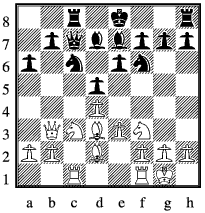
|
| RR v Derek Northage after 12 ... Rc8 |
17 ... Ne7, 18 Ne5
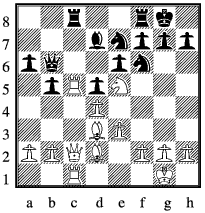
|
| RR v Derek Northage after 18 Ne5 |
18 ... Rxc5, 19 dxc5 My normal reaction would be take with queen so as to try to remove them before creating the passed pawn, but I decided I also liked my diagonal threats.
19 ... Qc7, 20 Bc3 Offering the c-pawn for his h-pawn, and getting the bishop onto the long diagonal.
20 ... Nc6, 21 Nxd7 Qxd7 As the h-pawn is going anyway, Derek decides to open some lines for an attack of his own.
22 Bxf6 gxf6, 23 Bxh7+ Kg7, 24 Bd3 Rh8, 25 Qe2 The game has switched sides - we've abandoned the queenside and gone for kingside action instead.
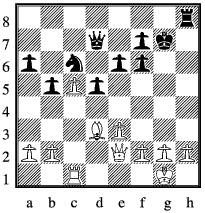
|
| RR v Derek Northage after 25 Qe2 |
27 ... Qh4, 28 h3 Rh6, 29 f4 deciding that keeping the black knight out of e5 is sensible.
29 ... Qg3, 30 Kh1 f6, 31 Rf1 Kf7, 32 Qf3 Now in boring mode
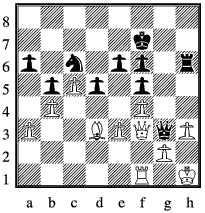
|
| RR v Derek Northage after 32 Qf3 |
Maybe the odd hiccup, but felt like my best play for some time.
comment on this article
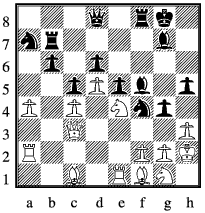
|
| RR v Craig Whitfield after 28 ... Rb7 |
About the only thing balanced about the position as we join the game with RR pondering his 29th move is material. On the queenside white has a space advantage and the prospects of targetting black's b-pawn, which is probably weaker than white's a-pawn. On the kingside it is black who has space advantage, though his pawn advance could see his king even more sparsely protected than white's. In the centre white's knight is well placed, but must be wary of moving as e4 from black would unleash black's dark square bishop. So a position of pluses and minuses, but overall one that as white RR was not unhappy with.
Unfortunately the game is played in the head, and RR's plan of waiting for the black advance to run into the ground is clearly a dangerous one, particularly against a strong player.
29 g3 Nxh3, 30 Nxh3 gxh3, 31 Bg5 RR deviates from his plan - Bxh3 is surely called for. The more material that is removed the happier RR should be. Instead he is seduced by the "clever" idea of using black's h3 pawn to hide behind.
31 ... Qd7, 32 Qe3 Bg4, 33 Be2 Inconsistent with having not removed the h-pawn. Bh6 would have been a natural continuation from the previous Qe3. This sort of oscillation between plans is never good.
33 ... Nc8, 34 f3 Bf5, 35 Bd1 Ne7
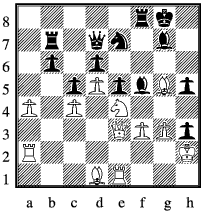
|
| RR v Craig Whitfield after 35 Ne7 |
36 a5 bxa5, 37 Ba4 (Rxa4 must be better, despite allowing an easily blocked check. At least then there is some possibility of play on the queenside. As it is craig is soon coming at RR from all angles.)
37 ... Qc7, 38 Bh6 Bg6, 39 g4 with intent to remove squares from black's light squared bishop, but just opening the f-file for black.
39 ... hxg4, 40 fxg4 Bex4, 41 Bxg7 Kxg7, 42 Qxe4 Rf4, 43 Qd3 Ng6
44 Rae2 Qf7, 45 Qe3 Rb4, 46 Bb5 a4, 47 Rg1 Rb3, 48 Qd2 Nh4 0-1
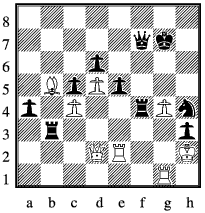
|
| RR v Craig Whitfield, final position |

|
| Rafal Stepien v Ian Jamieson White to play and win |